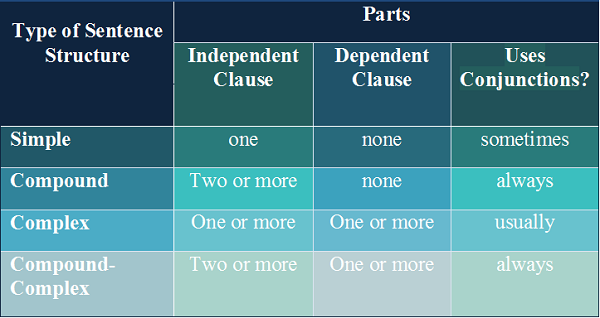
A sentence’s “structure” is the way its words are arranged.
In English, we have four main sentence structures: the simple sentence, the compound sentence, the complex sentence, and the compound-complex sentence. Each uses a specific combination of independent and dependent clauses to help make sure that our sentences are strong, informational, and most importantly, that they make sense!
In the examples, independent clauses are green , dependent clauses are purple , and conjunctions are orange . Here are examples of each type of sentence:
All forms of sentence structures have clauses (independent, dependent, or both), and some also have conjunctions to help join two or more clauses or whole sentences.
Independent clauses are key parts of every sentence structure. An independent clause has a subject and a predicate and makes sense on its own as a complete sentence. Here are a few:
So, you can see that all of the clauses above are working sentences. What’s more, all sentences have an independent clause!
A dependent clause is a major part of three of the four sentence structures (compound, complex, and compound-complex). It has a subject and a predicate; BUT, it can’t be a sentence. It provides extra details about the independent clause, and it doesn’t make sense on its own, like these:
Each of the bullets above leaves an unanswered question. By itself, a dependent clause is just a fragment sentence (an incomplete sentence). So, it needs to be combined with an independent clause to be a sentence.
A conjunction is a word in a sentence that connects other words, phrases and clauses. Conjunctions are a big part of compound, complex, and compound-complex sentences. The most common conjunction that you know is “and.” Others are for, but, or, yet, and so. Conjunctions are important because they let us combine information, but still keep ideas separate so that they are easy to understand.
Here are two sentences, with and without conjunctions:
Incorrect: The girl ran to the ice cream truck then she ate ice cream .
Correct: The girl ran to the ice cream truck , and then she ate ice cream .
So, you can see that we need a conjunction for the sentence to be clear!
It is important to know that the word “then” is NOT a conjunction—it’s an adverb.
As mentioned, there are four main types of sentence structures: simple, compound, complex, and compound-complex. To begin, here is a simple chart that outlines the patterns of each type.

A simple sentence has only one subject and one predicate—one independent clause. In fact, an independent clause itself is a simple sentence. Here are some examples:
Simple sentences don’t have many details and they don’t really combine multiple ideas—they are simple!
A compound sentence has at least two independent clauses. It uses a conjunction like “and” to connect the ideas. Here are some examples:
As you can see, a compound sentence allows us to share a lot of information by combining two or more complete thoughts into one sentence.
A complex sentence has one independent clause and one or more dependent clauses. It sometimes uses conjunctions and other words to combine all of the clauses together.
A great way to make a sentence more detailed is by adding dependent clauses (which couldn’t be sentences on their own). So, complex sentences let us add information to simple sentences.
A compound-complex sentence has two or more independent clauses and at least one dependent clause—so, it uses conjunction(s) to combine two complete sentences and at least one incomplete sentence. Here is an example:
The girl smelled cookies , which were baking at home , so , she ran all the way there .
The result of combining the three clauses and the conjunction is a compound-complex sentence that is both informational and easy to understand. The independent clauses give the main information, and the dependent clause(s) give the details.
When it comes to making sure your sentence is clear and complete, having the right sentence structure is very important. A couple of common mistakes can happen when you forget how to use clauses or conjunctions in the right way, like run-on sentences and fragment sentences.
In simple terms, a run-on sentence is a sentence that is too long. For instance, if a writer forgets to use conjunctions, a sentence seems like it “runs on” for too long. For example:
The fox really liked pancakes, he ate them every day for breakfast, he couldn’t eat them without syrup and butter .
But, with the right conjunctions, this can be a normal compound sentence:
The fox really liked pancakes , so , he ate them every day for breakfast ; but , he couldn’t eat them without syrup and butter .
As you can see, the new sentence is much easier to read and makes more sense.
A “fragment” is a small piece of something. So, a fragment sentence is just a piece of a sentence: it is missing a subject, a predicate, or an independent clause. It’s simply an incomplete sentence. Fragment sentences can happen when you forget an independent clause.
For instance, by itself, a dependent clause is just a fragment. Let’s use a couple of the dependent clauses from above:
As you can see, each leaves an unanswered question. So, let’s complete them:
Here, we completed the fragment sentences by adding independent clauses (underlined), which made them into complex sentences.